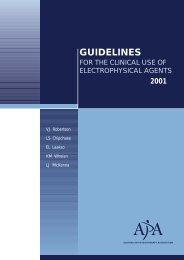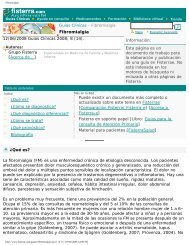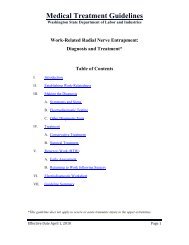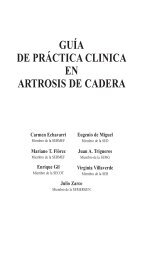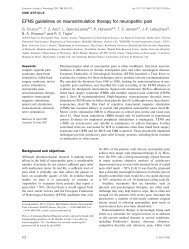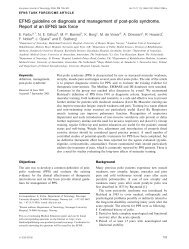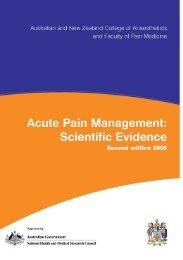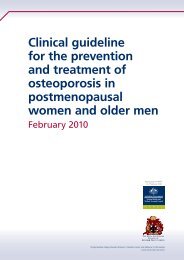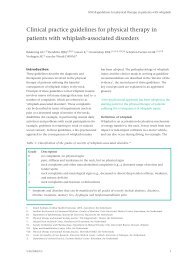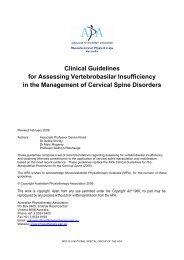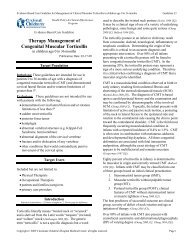Rheumatoid Arthritis
Rheumatoid Arthritis
Rheumatoid Arthritis
Create successful ePaper yourself
Turn your PDF publications into a flip-book with our unique Google optimized e-Paper software.
<strong>Rheumatoid</strong> <strong>Arthritis</strong>: Diagnosis and ManagementEffective Date: May 1, 2006ScopeThe guideline summarizes current recommendations for diagnosis and treatment of <strong>Rheumatoid</strong><strong>Arthritis</strong> (RA) for patients 16 years-of-age and older.Introduction<strong>Rheumatoid</strong> <strong>Arthritis</strong> (RA) is not a benign disease. RA is associated with decreased life expectancy.The risk of cardiovascular mortality is twice that of the general population. Affecting approximately1% of the adult population, RA is associated with considerable disability. RA adversely impacts anindividual’s quality of life and results in increased financial burden both to the individual and societythrough medical costs and loss of productivity.It is now well recognised that there is a “window of opportunity” early in the disease process to initiatetreatment which will fundamentally change the course of the disease. Treatment must be started earlyto maximise the benefits of medications and prevent joint damage. The use of traditional medicationsin combination and the new biologic therapies has revolutionised the paradigm of RA treatment inrecent years. 1In this new era of RA treatment, specialist care has become increasingly important in managingcomplex regimens. Access to timely specialized care is not universally available. This guideline isintended to aid in initiating early recognition and intervention and managing patients with this chronicdisease.The approach to care of patients with RA should be considered as falling into two groups.• Early RA (ERA) is defined as patients with symptoms of less than 3 months duration.• Patients with established disease who have symptoms due to inflammation and/or joint damage.The treatment approach varies depending on whether the symptoms arise from inflammation or jointdamage making the differentiation vital.BRITISHCOLUMBIAMEDICALASSOCIATIONMinistry ofHealth Services
Recommendations to improve quality of careRecommendation 1Differentiate inflammatory from non-inflammatory arthritisFEATURE INFLAMMATORY NON-INFLAMMATORYJoint pain With activity and at rest With activityJoint swelling Soft tissue BonyJoint deformity Common CommonLocal erythema Sometimes AbsentLocal warmth Frequent AbsentMorning stiffness >30 minutes 30 minutes• Painful swelling of 3 or more joints• Involvement of hands and feet (especially MCP and MTP joints)• Duration of 4 or more weeksDifferential diagnoses include: crystal arthropathy, psoriatic arthritis, lupus, reactive arthritis,spondyloarthropathies.N.B. Always consider infectionFeatures suggesting alternative diagnosis include• Mucosal ulcers, photosensitivity, psoriasis, skin rashes• Raynaud’s• Ocular inflammation• Urethritis• Inflammatory bowel disease• Infectious diarrhea• Nephritis• Isolated distal interphalangeal (DIP) jointsIt should be noted that extra-articular manifestations are an indication of more severe disease andthus have prognostic value. Established RA may have extra-articular manifestations including:CUTANEOUS OCULAR PULMONARY CARDIAC NEUROLOGICAL HEMATOLOGICAL• Nodules • Sicca • Pleuritis • Pericarditis • Peripheral neuropathy • Leukopenia• Vasculitis • Episcleritis • Nodules • Atherosclerosis • Cervical myelopathy • Anemia of chronic• Scleritis • Interstitial lung • Myocardial diseasedisease infarction • Lymphadenopathy• Fibrosis<strong>Rheumatoid</strong> <strong>Arthritis</strong>: Diagnosis and Management
Recommendation 3TestingRA is a clinical diagnosis. There are no tests that are completely reliable in making the diagnosis.Tests are primarily used to monitor the disease or exclude other types of arthritis.TESTS DIAGNOSTIC VALUE DISEASE ACTIVITY MONITORING COST (as of 2005)ErythrocyteSedimentation Rate(ESR) or C-ReactiveProtein (CRP)<strong>Rheumatoid</strong> Factor(RF)AntinuclearAntibody (ANA)Indicate only inflammatory process- very low specificityRF has low sensitivity and specificityfor RA. Seropositive RA has a worseprognosis than seronegative RA.Positive in cases with severe RA,systemic lupus erythematosus (SLE)or other connective tissue disorders(CTD).Most patients with positive ANA donot have RA, SLE, or CTD.Negative ANA usually excludes SLE.Often useful. ESR elevated in manybut not all with active inflammation.May be useful in monitoring diseaseactivity and response to treatment.ESR $2.46CRP $24.94No value $11.49No value - do not repeat $33.40X-RaysDiagnostic erosions rarely seen indisease of
At each visit:• List and assess current drug therapy including dose and monitoring for side effects (see DMARDtable in Appendix)• Assess patient for active joint inflammation and disease activity• Review Recommendation 1• Consider investigations: ESR or CRP• Focus exam to most troublesome joints• Differentiate inflammation versus damage• Scan for general health concerns, co-morbidities, and extra-articular manifestationsIf the assessment suggests ongoing active inflammation then:• review adherence to medication regimen, consider adjusting dosages or substituting/adding alternativemedications, consider referral to specialist, and consider referral to Physiotherapist (PT)and/or Occupational Therapist (OT) with expertise in RA.If the assessment suggests joint damage then:• consider referral to PT and/or OT• consider referral to Orthopaedic Surgeon• administer pain relieving modalitiesAlways consider that patients may have a combination of inflammation and damage.For surgical procedures consider neck instability, increased risk of infection,and implications of medications especially steroidsRecommendation 6Consider implications of chronic diseaseAs with all chronic diseases, optimal outcome is achieved through a multi-disciplinary approachcoordinated by the Family Doctor. Consider or review:• pain management• psychosocial issues• immunization (annual flu vaccine, pneumococcal vaccination)• osteoporosis assessment and preventive measures• RA is a risk factor for coronary artery disease. Consider dyslipidemia and minimize other riskfactors.• encourage Self-ManagementSummary<strong>Rheumatoid</strong> arthritis (RA) is not a benign disease and affects about 1% of the BC adult population.Early recognition and intervention clearly improves outcome. DMARDs, particularly when used early,change the disease process and have been proven to reduce damage and disability. Treatment ismulti-disciplinary involving regular follow-up, medications, physiotherapy, self-management and othersupport.<strong>Rheumatoid</strong> <strong>Arthritis</strong>: Diagnosis and Management
References and Resources:1. Guidelines for the Management of <strong>Rheumatoid</strong> <strong>Arthritis</strong> American College of RheumatologySubcommittee on <strong>Rheumatoid</strong> <strong>Arthritis</strong> Guidelines. <strong>Arthritis</strong> & Rheumatism 2002;46(2):328-346.2. Getting a grip on arthritis best practice guidelines The <strong>Arthritis</strong> Society. (2004).3. RA information and clinical resources available at www.rheuminfo.com4. British Society of Rheumatology Guideline on Standards of Care for persons with <strong>Rheumatoid</strong><strong>Arthritis</strong>. Kennedy T (Chair of the Guideline Working Group). BSR Rheumatology 2005 44(3):269-270. Available at http://rheumatology.oxfordjournals.org/cgi/reprint/44/4/5535. Canadian consensus statement on early optimal therapy in early <strong>Rheumatoid</strong> <strong>Arthritis</strong>. Bykerk BP,Baron M, Boire M, et.al. Available at: http://www.rheum.ca/Resources/pdf/ERA.pdf6. <strong>Rheumatoid</strong> <strong>Arthritis</strong>. Treatments. Matsumoto AK, Bathon J. Available at http://www.hopkinsarthritis.org/rheumatoid/rheum_treat.html.7. Search for a Physiotherapist by name or workplace: Physiotherapy Association of BritishColumbia 604 736-5130. http://www.bcphysio.org or http://www.bcphysio.org/app/index.cfm?fuseaction=public.home8. The <strong>Arthritis</strong> Society Toll free phone number: 1 800 321-1433SponsorsThis guideline was developed by the Guidelines and Protocols Advisory Committee, approved by theBritish Columbia Medical Association and adopted by the Medical Services Commission. Partialfunding for this guideline was provided by the Health Canada Primary Health Care Transition Fund.Revised Date: April 1, 2007This guideline is based on the scientific evidence at the time of the effective date.Guidelines and Protocols Advisory CommitteePO Box 9642 STN PROV GOVTVictoria BC V8W 9P1Phone: (250) 952-1347E-mail: hlth.guidelines@gov.bc.caFax: (250) 952-1417 Web site: BCGuidelines.caThe principles of the Guidelines and Protocols Advisory Committee are to:• encourage appropriate responses to common medical situations• recommend actions that are sufficient and efficient, neither excessive nor deficient• permit exceptions when justified by clinical circumstances.<strong>Rheumatoid</strong> <strong>Arthritis</strong>: Diagnosis and Management
Hydroxychloroquine(Plaquenil ® ‚ &generics)Sulfasalazine(Salazopyrin ® )Appendix: Disease Modifying <strong>Arthritis</strong> Drugs (DMARDs)• Note that all DMARDs take several weeks to work• Review medications if considering pregnancy as many are teratogenic• Dose is oral unless specifiedDrugCyclosporine**(Neoral ®Sandimmune ® ‚ &generics)Leflunomide**(Arava ® )Up to 6.5mg/kg leanbody weight1000 mgBID/TID2.5-4.5mg/kg/day10-20mg/dayMethotrexate 7.5 – 25mg/weekPO, IM, or SCMinocycline(Minocin ® )Gold sodiumthiomalate(Myochrysine ® &generics)Azathioprine(Imuran ® , generics)Adalimumab**(Humira ® )Anakinra**(Kineret ® )Etanercept**(Enbrel ® )Infliximab**(Remicade ® )Dose• nausea• cramps• diarrhea• rash• skin rash• nausea• headache• photosensitivity• hirsutism• gumhyperplasia• numerousdruginteractions• diarrhea• rash• abdominalpain• bloating• nausea• oral ulcers100 mg BID • photosensitivity10-50 mg IMQ 1-4 wks2-2.5 mg/kgdaily40 mg Q 2weeks SC100 mgSC/day25 mg SCtwice per wk3mg/Kg Q 8wks IV infusionCommon sideeffects• rash• pruritis• stomatitis• nausea• vomiting• diarrhea• rash• injectionsite reaction• blindness• myopathy• bone marrowtoxicity• renal toxicity• hypertension• cytopenia• infections• hepatitis• alopecia• hypertension• weight loss• bone marrowsuppression• hepatitis• infections• pneumonitis• hyperpigmentation• SLE• bone marrowsuppression• proteinuria• hepatitis• drug fever• bone marrowsuppression• infection• malignancy• infections• injection • infectionssite reactions(70%)• injectionsite reactions • infections• infusionreactionsSerious adverseeffects• infectionsMonitoringocular exam specific tohydroxychloroquine risk Q 6-12 moAppendix to Guideline: <strong>Rheumatoid</strong> <strong>Arthritis</strong>: Diagnosis and Management$25 - $50CBC and AST monthly for first 3 mos $10 - $20serum creatinine and blood pressureQ 2 weeks for first 3 mo, then Q 2 moif dose ≤ 2.5mg/kg/day or Q 4 weeksif > 2.5mg/kg/dayBefore start of therapy check:hepatitis serology, AST, ALT, CBC & BP.Check CBC, AST and ALT Q mo first 6mos, & Q 8 wks thereafter. CBC Q 2wks for first 6 mos, & Q 8 wksthereafter. Check BP monthly for 3 mos.Hepatitis B and C serology beforetreatment. Monthly CBC, AST, ALT, &creatinine for 3 mos then every 6-8wks. Creatinine & liver enzymes Q1-2 mo.CBC and urinalysis every 2 wks forfirst 3 mos then monthlyCBC and AST every 2 wks for first 3mos & then Q 3 mosTuberculin skin test, ANA, chest x-rayprior to initiating therapyTuberculin skin test, ANA, chest x-rayprior to initiating therapyTuberculin skin test, ANA, chest x-rayprior to initiating therapyTuberculin skin test, ANA, chest x-rayprior to initiating therapyApprox. monthly cost(as of nov. 2005)Solution:$200-$500Caps:$350 - $750$300 - $350$10 - $40$60 - $75$10 - $50$20 - $60$1,250 - $1,500$1,300 - $1,400$1400 - $1600$1000 - $2000** Drug is covered by the provincial drug program only with prior Special Authority approval from PharmaCare. Special Authority criteria and forms are available on thePharmaCare Web site at http://www.health.gov.bc.ca/pharme/sa/criteria/formsindex.html
<strong>Rheumatoid</strong> <strong>Arthritis</strong>A Guide for Adult PatientsEffective Date: May 1, 2006What is <strong>Rheumatoid</strong> <strong>Arthritis</strong>?<strong>Arthritis</strong> is a term used to describe conditions that involve pain and inflammation in the joints. Thereare over 100 different types of arthritis. <strong>Rheumatoid</strong> <strong>Arthritis</strong> (RA) is the most common type ofinflammatory arthritis. When a joint is inflamed it is painful, swollen, hot and stiff. This inflammationis in the lining of the joints, and if it is not controlled, it will cause permanent damage to the bone andcartilage. RA affects ~1% of the adult population and affects women more than men. RA can start atany age but most commonly occurs in the 30-50 age group.What is the cause of <strong>Rheumatoid</strong> <strong>Arthritis</strong>?The cause of RA is not yet known but there is continuing research. It seems most likely that a virustriggers the person’s immune system to react in an abnormal way. This produces inflammation in thelining of the joints. We don’t know why this causes continuing joint inflammation. We do know thatthere is an inherited gene that makes some people more likely to get RA. Not everyone with this genewill get RA.How do I know if I have <strong>Rheumatoid</strong> <strong>Arthritis</strong>?When RA starts it may be sudden or gradual. The pain or stiffness with swelling in joints is usuallyworse in the morning. Any joint may be involved but it commonly starts in the fingers, wrists and feet.RA usually involves many joints but at onset there may be only one or two joints affected. Your doctorwill look for clues that might suggest the joint inflammation could be another type of arthritis. Bloodtests help give clues but there is no blood test to completely diagnosis RA. It often takes months toconfirm a diagnosis of RA.What treatments are available?Modern medications can control most of the joint inflammation. There is no cure at this time but theimpact of RA can be minimized. It is important to start medications early. Your doctor will discussthese with you and probably will refer you to an arthritis specialist or rheumatologist. It is important toremember that the small risks associated with medications are worth taking to prevent permanent jointdamage.Regular exercise is important. With painful joints you may need to see a physical therapist. You willlearn how to exercise inflamed joints safely and how to stay fit. An occupational therapist can adviseyou how to reduce stress to your joints while continuing your daily activities.Lifestyle issues are also important. These include a healthy diet, weight control, reducing stress,stopping smoking and proper rest.What can I do?Learn more about the disease and work towards meeting self-management and lifestyle goals.Take an active role, as a partner with your physician, in treating your RA. Talk to your family doctorif you have concerns about: nutrition, exercise, support groups, stress and depression, sexual/reproductive health, financial and employment issues (pension and housing), and child care support.
Resources for people affected by rheumatoid arthritis:• The <strong>Arthritis</strong> Society Web site: www.arthritis.ca• <strong>Arthritis</strong> Information Line (toll free): 1 800 321-1433• <strong>Arthritis</strong> Foundation: www.arthritis.org• <strong>Arthritis</strong> Consumer Experts: www.arthritisconsumerexperts.org• Find a Physical Therapist: www.bcphysio.org or 1 888 736-5645• Dial–A–Dietitian Nutrition Information Society: www.dialadietitian.org or 1 800 667-3438• Search for an occupational therapist in BC by name, professional interest or workplace:www.bcsot.org• B.C. Chronic Disease Management Web site provides patient information and resources oncommon chronic illnesses: http://www.health.gov.bc.ca/cdm/patients/index.html• BC NurseLine for advice and information any time of day or night at:604 215-4700 (Greater Vancouver)1 866 215-4700 (toll free) if outside the lower Mainland1 866 TTY-4700 deaf and hearing-impaired (toll-free province-wide)• To see patient guides for other chronic conditions and the physician’s guideline for rheumatoidarthritis, visit the Guidelines and Protocols Web Site at www.health.gov.bc.ca/msp/protoguides/gps/• BC HealthGuide Handbook available at www.bchealthguide.org• Buy from a bookstore or borrow from the library The <strong>Arthritis</strong> Helpbook: A TestedSelf-Management Program for Coping with <strong>Arthritis</strong> and Fibromyalgia by Kate Lorigand James Fries, published by Da Capo Press. Several editions are available, withinformation on the 2006 edition at: http://www.perseusbooks.com/perseus/book_detail_redirect.do?imprintCid=DC&isbn=0738210382BRITISHCOLUMBIAMEDICALASSOCIATIONMinistry ofHealth Services



